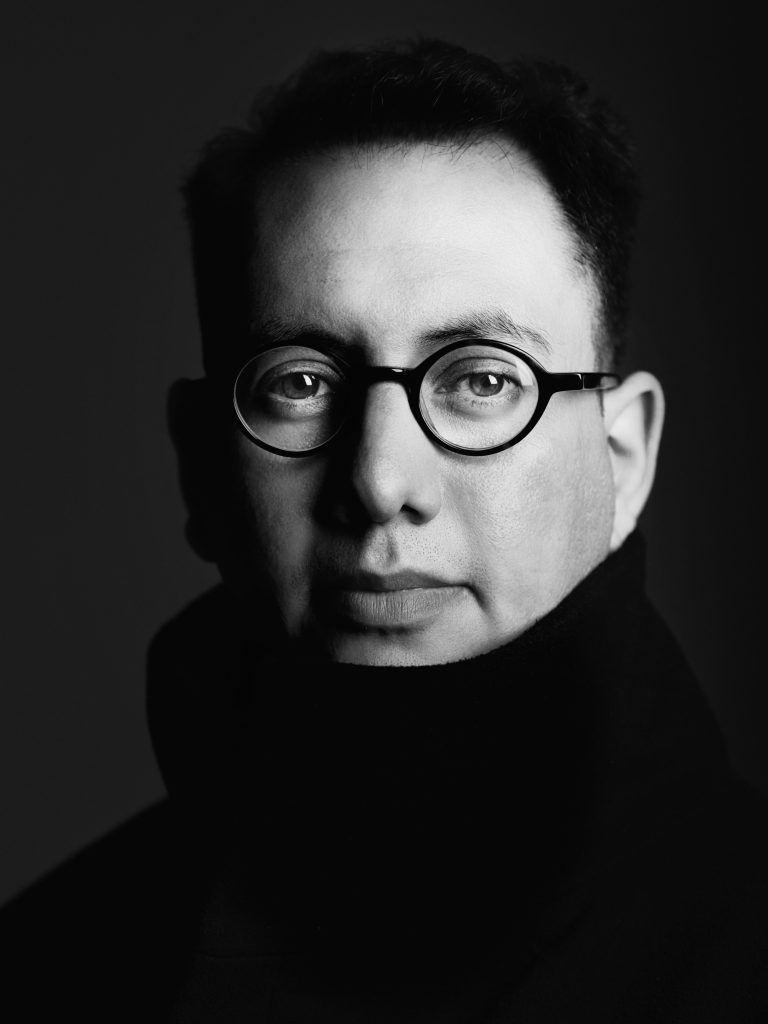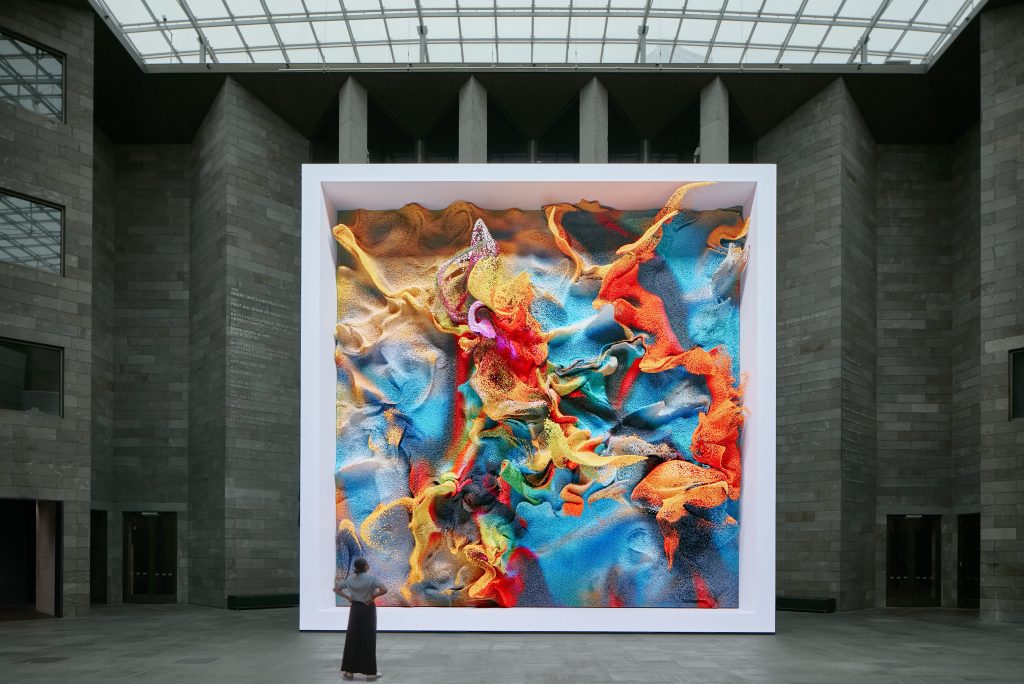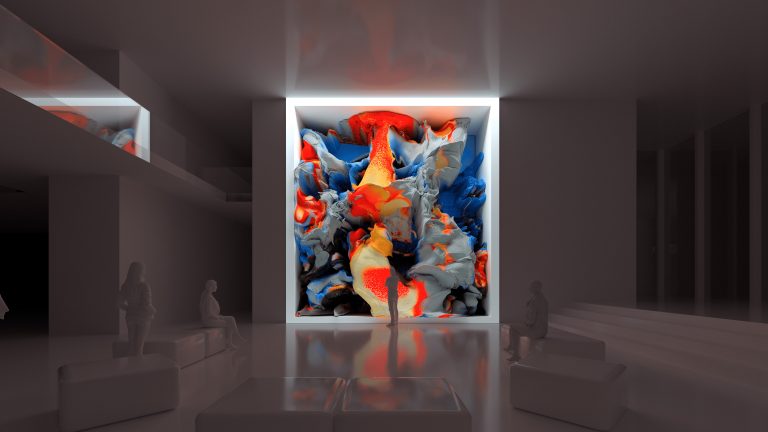
Photography by SERGE HOELTSCHI

Quantum Memories
NGV Triennial, 2020
Photography by TOM ROSS
Refik Anadol explores how time and space radically changing now that technologies have become an integral part of our everyday lives. From his recent exhibition Unsupervised at the MoMA New York, to WDCH Dreams (2018–), which was originally projected onto Frank Gehry’s iconic Walt Disney Concert Hall in Los Angeles, the multi-award-winning Turkish-American artist is a master of reconstructing realities. He does so by combining new media technology and data with art and physical experiences via what is called ‘post-digital architecture,’ inviting his viewers to a sensorial and disruptive experience through beautiful abstract forms, colours, and simulated textures.
Join us for an inspiring interview with Refik Anadol, as he shares his thoughts on AI as a co-creative tool, the power of scale in his work, and the growing intersection of art, science, and technology.
hube: The colour palette available to digital artists is almost limitless; the freedom and possibilities that such a range offers seems intimidating. How do you handle working with so many options?
Refik Anadol: I think artificial intelligence is like my assistant. My colour palette comes from the data archive that I use, and it can be clouds, this can be flowers, nature, cities—I don’t have any bias about the colour in the very first stage. Let’s say we’re talking about all the flowers in the world, maybe seven million images of flowers collected. Can you imagine that perhaps 16,000 species exist in nature? And I can paint with all their colours. I think it’s a huge privilege rather than a problem or challenge. I let AI create these moments for me; and sometimes I don’t like the color palette so I manipulate it, like a co-creation. It’s a 50-50 human-machine collaboration. What is amazing is that to make this happen, over the last seven years I’ve been writing software. I was looking for a tool that didn’t exist in the art world so I had to create a new approach to creativity with AI. But now, I mostly use the freedom of my imagination.
h: The size of your artworks changes the way that they are perceived. Such scale is thrilling: it seems capable of both enchanting and overwhelming the audience. Scale is clearly an important element of your work. How do you work with it?
RA: My general feeling about making art started with architecture. Back in 2008, I coined ‘data painting.’ Since then, I’ve always imagined architecture as a canvas. Architecture means it’s bigger than us. From its surfaces to walls to facades, these are things that have a significant impact on our everyday lives. This can be a building-like cultural beacon like Frank Gehry’s Disney Hall, Zaha Hadid’s museums, or Gaudi’s Casa Batlló. I consider them my heroes. So, my understanding of scale starts with architecture and, when I start with that, I always imagine the works I’ve been doing in public spaces have something to say about architecture. It’s not coming from ego, it’s coming from architecture references. If I think like this, then our works like in Art Basel Miami or Podostrog or in MoMA and many other locations where we really challenged the scale to give an architectural contextto artwork. To me, scale comes from that perspective.
h: Your data-driven algorithms create works that seem to imitate organic life. This is frightening and captivating at the same time, much like everything related to AI theory. What are your thoughts on the future of human-machine relations? Do you have any concerns?
RA: I think there will be a 100-percent shift in the quality of creativity. Finally, people are starting to understand how powerful these algorithms can be. However, there is also this problem linked to it, and the idea of creating art isn’t just prompt engineering, it’s not just plotting a bunch of images on text. Creativity also starts after that. How do we exhibit it, how do we share these things, how do we put our own ways of thinking in it? I think that’s a very important part that will make a new lead in creativity and create new ways of seeing creativity. I’ve always seen AI as an extension of the human mind and not a threat. It’s a way to enhance it, and to do so a lot of thinking is required. Let’s imagine an artist who is always working with the same brush and the same pigment and canvas. Every morning when you wake up you have the same tools. But when it comes to AI everything has changed the next morning. It’s not a place for people who wish to stay in their comfort zone, it’s a place for people who welcome changes, evolutions, and finding new journeys. We have to be sure that this creativity comes with these other challenges and reality.
h: A significant group of people see NFTs solely as an information storage technology, one that does not generate new artistic techniques or expand the creative freedom of the artist. What is your opinion on this?
RA: I think it is giving us new ways and new perspectives. It’s true that it is still a technique of sharing, a technique of creating an asset in a blockchain and validating the owner and the collector. I’m aware of this, but it also creates transparency and gives the collector the opportunity to own something beyond just a static image or video. This is where I get excited. Of course, there is also the charity aspect. I was able to contribute in making a positive impact, in particular during the earthquake in Istanbul or through UNICEF or Alzheimer foundations. I would not have done that if it weren’t for the ex istence of NFTs. We’ve donated more than $5-million dollars to charity. They allowed me to enlarge and reach out to my audience, creating communities around my work.
I’ve been working for more than 10 years, but I didn’t have this function of sharing and selling. I think that my community is part of something bigger than me, than us. The function is bigger than the technique, [which isn’t] the only thing that inspires [others]. In the beginning it was inspiring to many people—writing, open-sourcing, being transparent in the blockchain as opposed to the physical galleries in the world.
I don’t have gallery representation. I’ve been independent since day one. I’ve worked with galleries, of course, for some exhibitions, but I don’t have any of them representing me, being on my back 24/7. It’s important for artists making independent movements, this facilitates a lot, giving you the power to share, sell, exhibit, and exchange. It’s a brilliant and powerful tool for artists and for ecosystems. Before there was a lack of value for the system, digital art wouldn’t get the same intention as before. I think it solved more problems than just technical features.

